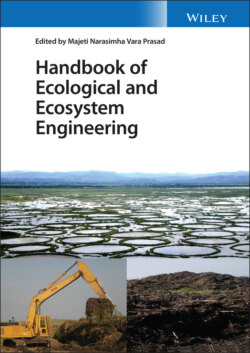Читать книгу Handbook of Ecological and Ecosystem Engineering - Группа авторов - Страница 24
2.2.2 Limited Soil Drainage and Shallow Rooting Depth
ОглавлениеDescription of the marginality factor: Part of the growth and survival strategy of plants is related to the depth and distribution of their roots, especially in ecosystems where water is a limiting factor [65]. Here, roots play a predominant role for hydrological and biogeochemical cycling [66]. The depth of rooting is governed by the depth of water infiltration and is strongly influenced by the soil's properties, the moment and magnitude of water intake, and evaporative demand [66]. Plant species exposed to water stress, such as slight soil moisture deficiencies, have deeper root profiles [66]. In general, roots tend to be deeper in ecosystems limited by water, colder regions, humid climates, or places where the rainy season occurs during the winter. The deepest roots are found in arid environments where a long dry season occurs and water is limited, and where the penetration of the roots seems to be related to the depth of infiltration and the intensity of evaporative demand [66]. Also, soil compaction can lead to limited drainage, shallow rooting depths, negative effects on soil porosity and gas transport properties, reduction of critical levels of aerobic microbial activity, and promotion of N2O emission [10,15–17, 67].
Revitalization by ecological engineering: Microbially induced calcite precipitation has been referred to as a method that uses bacteria and cementation solutions to effectively reduce oil cracking [68]. Other physical methods and approaches to reduce the cracking of clayey soil include compaction control, geogrid, and plant root reinforcement [69]. Compaction control and similar technologies have high associated costs and low long‐term maintenance [68].
Revitalization by ecosystem engineering: Introducing perennial and annual plants capable of enduring these soil conditions may be a solution. Mechanical stresses and chemical stimuli exerted by soil conditions may affect the ability of plant roots to penetrate the soil. The physical force that the soil exerts on the root of a plant that tries to penetrate along the soil profile is influenced by the soil's density, porosity, and, above all, moisture [70]. Several alternatives have been used, such as the plows and chisels, cover crops, and species with strong root systems and high biomass production, among other management techniques [70]. Other plant species have developed adaptive responses to these conditions by increasing or decreasing the rate of elongation of the apical region, swelling or shrinking its diameter [71]. In Europe, it is easier to find shallow soils in mountainous slope areas. A threshold of 30–35 cm relative to the rooting depth constitutes a severe restriction on the cultivation of perennial crops (or other crops) such as giant reed and switchgrass [61]. Shallow soil implies limited nutrients and water resources, as well as very limited soil workability [61].
Biomass crops other than switchgrass and giant reed can be adapted to such soil conditions or modify their marginal aspects. Cardoon fields, for example, do not suffer from soil compaction [64, 72]. The roots of perennial plants can also accelerate the decomposition of organic matter in the soil in the long term through the action of biological and physical mechanisms [73]. Miscanthus spp. can be used to rehabilitate ecosystem functions and physical properties of marginal soils such as mine soils [74]. However, the mechanization associated with its cultivation can also cause the reverse effect. Switchgrass can also be well‐adapted to shallow soil depth and light soils with reduced fertility [75]. Introducing those industrial crops in these soil types can ameliorate the soils through the increment of organic matter and structure [76]. When explored for biomaterials, bioproducts, biochemicals, and bioenergy can help revitalize these areas economically.
